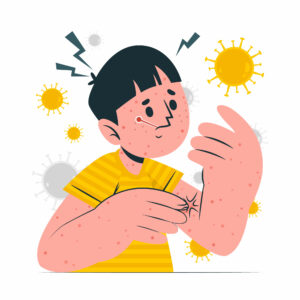LONDON (Thomson Reuters Foundation) – The urgency of Abdirizak Ahmed’s efforts to fight a measles outbreak in Ethiopia hit home last month when two of the aid worker’s colleagues lost children to the disease, which is making a comeback from Africa to India and Britain.
“Both boys died before they reached the 13th month or 14th month of life … It’s devastating,” said Mr. Abdirizak, who works for charity Save the Children in the Horn of Africa country, which reported 10,000 cases in 2023 – the world’s highest toll after Yemen, Azerbaijan, Kazakhstan and India, according to World Health Organization (WHO) data.
COVID-19 disrupted routine vaccinations against measles globally in 2020 and 2021, leaving millions of children – mostly in poorer countries – unprotected against one of the world’s most contagious diseases, which can cause blindness, pneumonia and death.
“Most of the people dying from this outbreak are children. Before they get to enjoy their childhood, they are taken away by this easily preventable disease,” Mr. Abdirizak told the Thomson Reuters Foundation by phone from the eastern city of Jijiga, where he works as an area director for the aid group.
In what health experts have called the biggest backslide in a generation, 51 countries – mostly in Africa – experienced large and disruptive measles outbreaks last year, up from 37 in 2022 and 22 in 2021.
And it is set to get worse.
By the end of 2024, over half of all countries – about 105 – will be at high risk of a measles outbreak, according to data shared with the Thomson Reuters Foundation by the US Centers for Disease Control and Prevention (CDC).
Of those countries that are at risk, nearly half are low- and low-middle income countries, with children most likely to contract the disease, a CDC spokesperson said by email.
VACCINE HESITANCY
Measles typically causes a high fever, cough and a tell-tale rash. In pregnant women, it raises the risk of miscarriage and premature birth.
Over the years, however, the success of the measles vaccine has led to complacency about the dangers that has fanned vaccine hesitancy, health experts say. A growing number of parents in countries where measles has long been eradicated, including in the United States and Europe, now choose not to inoculate their children.
Measles cases had been falling worldwide until 2016, when rising vaccine hesitancy due to misinformation and a growing lack of trust in government health authorities saw a reversal.
The WHO said in December there was a 30-fold rise in measles cases across Europe. Britain, which had eliminated the disease in 2017, is now scrambling to contain surging infections due to falling vaccine uptake.
Confidence in the importance of childhood vaccines against killer diseases like measles and polio fell during the pandemic in 52 of the 55 countries surveyed by the U.N. children’s agency UNICEF in 2023.
Niklas Danielsson, senior immunization specialist at UNICEF, said misinformation around COVID vaccines might have eroded trust in other vaccines.
“You had a situation where there were very heated debates in the public, on social media and a lot of rumors and misinformation about the COVID vaccine not being safe,” he said.
“That has impacted on the demand for vaccinations. And trust is something that has to be built back slowly and consistently over time.”
‘TIP OF THE ICEBERG’
Measles is preventable with two doses of vaccine. However, 22 million children worldwide missed their first dose in 2022 and another 11 million their second dose, a slight improvement on the previous year, according to the WHO.
In 2022, cases jumped by 18% to an estimated 9 million, and deaths to 136,000, mostly among children, found an analysis by researchers at the WHO and CDC published in November 2023.
“The size of the outbreaks and the total number of cases reported are increasing. That’s a real concern, but that is just the tip of the iceberg because there’s a lot of underreporting,” said Danielsson.
The situation has not improved at all since the pandemic in low-income countries, where the risk of dying of measles is highest, said the WHO. Vaccination rates there are at 66% on average, compared to the 95% the U.N. agency says is needed to prevent outbreaks.
African health systems are especially at risk due to a lack of funds and staffing, particularly in countries such as Ethiopia where conflict, droughts, flooding and malnutrition make children more vulnerable to deadly infection, aid groups and health experts say.
“When things go wrong, the countries with the least resources will feel the biggest impact,” said Natasha Crowcroft, senior technical adviser for measles and rubella at the WHO.
“Measles tells you where you’ve got gaps in your system – and this year is looking like it’s going to be a terrible year for measles.”
RESILIENT HEALTH SYSTEMS
Boosting the resilience of health systems and prioritizing routine immunizations, especially in poorer countries, are key to preventing outbreaks, said Thabani Maphosa, who oversees worldwide operations at global vaccine alliance Gavi.
“When you have to respond to any outbreak you are actually taking resources away … to respond to a fire,” said Maphosa, managing director of country programs delivery.
WHO’s Crowcroft said it was crucial to tackle existing diseases that already have effective vaccines instead of focusing too much on future pandemics.
“The best way to be ready for the next pandemic is to build really strong systems that are dealing with what we’re facing now,” she said.
Global efforts to contain measles outbreaks are under way.
Gavi is ramping up measles vaccinations this year and aims to reach 38.5 million children in 15 countries including Burkina Faso, Cambodia and Chad.
“If each one of us plays our part – we bring the vaccine, the government makes sure the health workforce is there, and the community makes sure it overcomes misinformation and brings children – then we win,” Ms. Maphosa said. – Reuters

